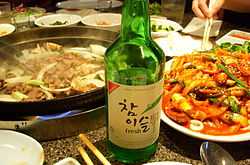Anju (food)
| Anju | |
|---|---|
|
| |
| Course | Hors d'oeuvre |
| Place of origin | Korea |
| Main ingredients | Any combination of appetizer and alcoholic beverage |
|
| |
| Anju | |
| Hangul | 안주 |
|---|---|
| Hanja | 按酒 |
| Revised Romanization | anju |
| McCune–Reischauer | anchu |

Anju (Korean pronunciation: [andʑu]) is a general term for a Korean food consumed with alcohol. It consists of a variety of foods, including both main dishes and side dishes. Consuming food with alcohol is a widespread practice in Korea, especially when the alcoholic beverage soju is involved.[1][2]
Certain types of foods consumed primarily as Anju include golbaengi muchim, nogari with peanuts, and jokbal.
History
Until the Chosun Dynasty, alcohol was mainly served in jumaks (a type of inn or tavern), where soups with rice, along with traditional alcohol such as makgeolli, were served to guests. Since the introduction of beer and Western foods into Korea, mainly from Japan in the nineteenth century, bars and pubs have enjoyed a newfound popularity, and many types of Western foods have been consumed as anju.
By types of liquor
Some foods are considered to be best complemented by certain types of alcohol. For example, samgyeopsal, barbecued pork belly, is considered to go best with soju, while fried chicken or Korean seasoned chicken goes well with beer. Pa-jun and makkeoli (or dongdongju) is a popular combination for rainy days.
By the place where alcohol is served
There are a number of different types of bars in South Korea, and each category sells different kinds of food and alcoholic beverages.
- Jumak: this does not refer to the traditional Korean inns of the Chosun Dynasty mentioned above, but instead refers to a conceptual bar based on Korean culture. These bars are represented by traditional anju such as pa-jun, dubu-kimchi, or dotori-muk.
- Hof house (Korean pronunciation: [hopʰu ha.usʰɯ]): Hof houses (a German loan word) sell a number of relatively inexpensive alcoholic beverages. Various international dishes are served here as well.
Sample images
-

Nogari (young Alaska pollock) with peanuts
-

Nakji bokkeum with somyeon (fried octopus in gochujang with fine noodles)
See also
References
- ↑ Pettid, Michael J. (2008). Korean cuisine: an illustrated history. China: Reaktion Books Ltd. pp. 110–123. ISBN 978 1 86189 348 2.
- ↑ "Food and drinks the Korean way". Los Angeles Times. 2011-05-26. Retrieved 30 April 2013.
- "Anju (안주)" (in Korean). The Hankyoreh. 2003-11-16. Retrieved 2008-02-18.
- "Anju (안주)" (in Korean). 한국민족문화대백과, 한국학중앙연구원.
External links
| Wikimedia Commons has media related to Anju. |

